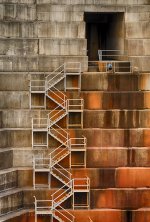You are using an out of date browser. It may not display this or other websites correctly.
You should upgrade or use an alternative browser.
You should upgrade or use an alternative browser.
Vixens 365 Project 2014
- Thread starter Vixen
- Start date
dh photography
Senior Member
The hinge on the bottom of the case is broken David. Took it to an antique place that does repairs and was told it's not worth repairing. I'm going to hang on to it and see if I can get another case. That way I can get the inners swapped into it at less cost. It WAS still working but lost abt 10 mins in every 24hrs (I was told) but I have not tried it as yet myself.
I may take it to another antique jewellers if I can find one that does repairs. Second opinion
View attachment 125293
View attachment 125294
View attachment 125295
View attachment 125296
I'd certainly get another opinion on that case. It may very well turn out that the case has more value than the whole watch given that it appears to be solid Sterling Silver. Looking quickly at the in inside, I don't see a maker's mark on the watchworks. If I get a few minutes I'll look closer and also dig into my silver markings references to see if that leads me in the right direction.
If it's running, but is slow, a good watchmaker/repair person should easily be able to clean it and check the spring. Parts for even the oldest of movements are usually still findable fairly easily (if they want to look).
sonicbuffalo_RIP
Senior Member
Interesting Pat!
Vixen
Senior Member
I'd certainly get another opinion on that case. It may very well turn out that the case has more value than the whole watch given that it appears to be solid Sterling Silver. Looking quickly at the in inside, I don't see a maker's mark on the watchworks. If I get a few minutes I'll look closer and also dig into my silver markings references to see if that leads me in the right direction.
If it's running, but is slow, a good watchmaker/repair person should easily be able to clean it and check the spring. Parts for even the oldest of movements are usually still findable fairly easily (if they want to look).
I couldn't find a makers mark on the movement either
Found another repairer. Will take it to them and see what happens
Last edited:
sonicbuffalo_RIP
Senior Member
Nice picture, Vixen!
wud
Senior Member
21st Nov....324/365.....Red-Backed Wren
The more I use my Tamzooka, the more I love it.
View attachment 124827
It's a brilliant shot and the background are SO awesome!
dh photography
Senior Member
Ok. Bear with me on the long post. (you'll get the pun in that in a sec.) I've found some info on the case for you. Definitely good news. Haven't looked for any maker data yet as I'd need much closer detailed pics if possible. The case is Swiss and is definitely silver. Not a fortune, but better than a poke in the eye! Read below:

Silver 0.935 Watch Case with three Swiss bears
The Three Bears
Neither of the standards of purity defined for silver in the Swiss Precious Metals Control Act of 1880 (0.800 and 0.875) met the UK minimum standard of sterling silver, 0.925 or 92.5% silver content, so items with these levels of silver content in the metal could not be hallmarked, or legally sold, in Britain.
Before 1880 the vast majority of Swiss watches sold in Britain were imported without any assay or hallmarking at all. After 1880, when the Swiss introduced their own hallmarking process, Swiss watches were assayed and hallmarked in Switzerland, but to the lower Swiss standards, not sterling. This was not legal, but no one realised at the time. A small proportion of Swiss watch cases were assayed and hallmarked in the UK between 1874 and 1888, and a higher grade of silver was used for these to meet the British sterling silver standard.
The British Merchandise Marks Act of 1888 introduced new requirements for imported gold and silver watches. From 1 January 1888 they all had to be hallmarked, either in a British assay office or in their country of origin. The Act also defined new styles of hallmarks to be struck by UK assay offices on imported gold and silver watches. As a result of this the customs authorities stopped allowing into the UK Swiss watches with silver cases of either the 0.800 or 0.875 standard. As a consequence of this, a higher standard for silver of 0.935 was adopted in Switzerland to comply with the British legal minimum of sterling silver.
This was discussed at a Swiss Federal Council meeting and is recorded in a decree dated 24 December 1887. It is apparent from that document that the Swiss authorities thought that sterling silver was actually 0.935, which explains why this standard, higher than necessary to meet British standards, was adopted. The reason for assuming this is not explained, but the mark of sterling is the lion passant, the walking lion with raised right forepaw; the widely recognised mark of sterling silver since 1544 which doesn't reveal the exact analysis of sterling silver. A Swiss clerk tasked with the job of framing the new standard might have found the official British definition of sterling silver of eleven ounces and two pennyweight of pure silver in the pound troy, and then read about some of the medieval disputes about whether this meant before assaying or "out of the fire", and decided to simply get hold of a piece of sterling silver and have it tested. An alloy that was on average slightly above standard was often used to make sure that the work passed the assay, because items below standard were be "battered" and the workmanship was lost, so when the selected piece of sterling silver was tested in Switzerland it asayed at 0.935, hence the mistake.
To confirm that a watch case had assayed at 0.935 or better another mark was needed, to distinguish it from the 0.875 indicated by a single bear. It was decreed by the Swiss authorities that a mark with three bears, one small and two large as shown in the picture, was stamped in the case backs of watches that were to be exported to England. The bows of such watches were stamped with two bears, as shown by the red arrows in the picture here. Another bear was stamped on the pendant as shown by the single third arrow.

Silver 0.935 bow with two bears
The mark of the three bears was not universally appreciated. Customers in the United States (for one) preferred to see one bear rather than three. Because of this, watch cases of 0.935 silver that were submitted to the Bureaux de Contrôle (assay offices) in packets identified with "Destinée à l'Angleterre" were stamped with three bears; without this identification they were stamped with a single bear. The manufacturers could therefore choose whether to have three bears or one bear stamped on 0.935 silver watch cases by marking the packets "Destinée à l'Angleterre" if they wanted three bears, or omitting this if they wanted a single bear.
The use of 0.935 silver and the three bears marks was discussed in La Fédération Horlogère Suisse in October 1890, when it appears that there had been a suggestion by the authorities that the practice should be discontinued. The watch manufacturers were strongly of the view that it was necessary for watches that were to be exported to England, because English customers recognised and appreciated the mark of the three bears.
From 1 June 1907 a British law originally passed in 1842 was correctly implemented, and from then on all imported Swiss watches were assayed in Britain and marked the new British import hallmarks, and after this date they very rarely also have Swiss hallmarks; there would have been little point in getting them assayed and hallmarked twice. I think that the use of the three bears, which was specifically for the British market, probably also ceased in 1907 when Swiss hallmarking of watches "Destinée à l'Angleterre" itself ceased.

Silver 0.935 Watch Case with three Swiss bears
The Three Bears
Neither of the standards of purity defined for silver in the Swiss Precious Metals Control Act of 1880 (0.800 and 0.875) met the UK minimum standard of sterling silver, 0.925 or 92.5% silver content, so items with these levels of silver content in the metal could not be hallmarked, or legally sold, in Britain.
Before 1880 the vast majority of Swiss watches sold in Britain were imported without any assay or hallmarking at all. After 1880, when the Swiss introduced their own hallmarking process, Swiss watches were assayed and hallmarked in Switzerland, but to the lower Swiss standards, not sterling. This was not legal, but no one realised at the time. A small proportion of Swiss watch cases were assayed and hallmarked in the UK between 1874 and 1888, and a higher grade of silver was used for these to meet the British sterling silver standard.
The British Merchandise Marks Act of 1888 introduced new requirements for imported gold and silver watches. From 1 January 1888 they all had to be hallmarked, either in a British assay office or in their country of origin. The Act also defined new styles of hallmarks to be struck by UK assay offices on imported gold and silver watches. As a result of this the customs authorities stopped allowing into the UK Swiss watches with silver cases of either the 0.800 or 0.875 standard. As a consequence of this, a higher standard for silver of 0.935 was adopted in Switzerland to comply with the British legal minimum of sterling silver.
This was discussed at a Swiss Federal Council meeting and is recorded in a decree dated 24 December 1887. It is apparent from that document that the Swiss authorities thought that sterling silver was actually 0.935, which explains why this standard, higher than necessary to meet British standards, was adopted. The reason for assuming this is not explained, but the mark of sterling is the lion passant, the walking lion with raised right forepaw; the widely recognised mark of sterling silver since 1544 which doesn't reveal the exact analysis of sterling silver. A Swiss clerk tasked with the job of framing the new standard might have found the official British definition of sterling silver of eleven ounces and two pennyweight of pure silver in the pound troy, and then read about some of the medieval disputes about whether this meant before assaying or "out of the fire", and decided to simply get hold of a piece of sterling silver and have it tested. An alloy that was on average slightly above standard was often used to make sure that the work passed the assay, because items below standard were be "battered" and the workmanship was lost, so when the selected piece of sterling silver was tested in Switzerland it asayed at 0.935, hence the mistake.
To confirm that a watch case had assayed at 0.935 or better another mark was needed, to distinguish it from the 0.875 indicated by a single bear. It was decreed by the Swiss authorities that a mark with three bears, one small and two large as shown in the picture, was stamped in the case backs of watches that were to be exported to England. The bows of such watches were stamped with two bears, as shown by the red arrows in the picture here. Another bear was stamped on the pendant as shown by the single third arrow.

Silver 0.935 bow with two bears
The mark of the three bears was not universally appreciated. Customers in the United States (for one) preferred to see one bear rather than three. Because of this, watch cases of 0.935 silver that were submitted to the Bureaux de Contrôle (assay offices) in packets identified with "Destinée à l'Angleterre" were stamped with three bears; without this identification they were stamped with a single bear. The manufacturers could therefore choose whether to have three bears or one bear stamped on 0.935 silver watch cases by marking the packets "Destinée à l'Angleterre" if they wanted three bears, or omitting this if they wanted a single bear.
The use of 0.935 silver and the three bears marks was discussed in La Fédération Horlogère Suisse in October 1890, when it appears that there had been a suggestion by the authorities that the practice should be discontinued. The watch manufacturers were strongly of the view that it was necessary for watches that were to be exported to England, because English customers recognised and appreciated the mark of the three bears.
From 1 June 1907 a British law originally passed in 1842 was correctly implemented, and from then on all imported Swiss watches were assayed in Britain and marked the new British import hallmarks, and after this date they very rarely also have Swiss hallmarks; there would have been little point in getting them assayed and hallmarked twice. I think that the use of the three bears, which was specifically for the British market, probably also ceased in 1907 when Swiss hallmarking of watches "Destinée à l'Angleterre" itself ceased.
Last edited:
Vixen
Senior Member
David......thankyou so much for that. I can see now the 09935 that is stamped on the case means 935 standard silver from Switzerland. I am guessing this was my partners grandmothers watch as I said, so 1887 - 1907 would be a reasonable timeframe, as she would have been born 1900 +-10yrs at a guess.
I looked on the watch bow and can see 2 stamps as shown in your post but couldn't see the third stamp on the winder although there IS a mark but it's very hard to see if it is an actual hallmark stamp.
I wound the watch after reading your post and was very pleased to hear it ticking. My M-in-L said it worked. She was right. I hope to take it to the repairers I have found next week for a quote. I spoke to one of the repairers on the phone and am more hopeful now that it can be fixed. I just think it is too nice NOT to fix it and I'd love to be able to wear it around my neck.
OK...I am happy to take some more shots of the movement if you think there is possibly a makers mark on it but to be honest I cannot see anything when I look at it with my magnifying glass
Thankyou, thankyou, thankyou again You've made me much happier about this watch now
You've made me much happier about this watch now 
I looked on the watch bow and can see 2 stamps as shown in your post but couldn't see the third stamp on the winder although there IS a mark but it's very hard to see if it is an actual hallmark stamp.
I wound the watch after reading your post and was very pleased to hear it ticking. My M-in-L said it worked. She was right. I hope to take it to the repairers I have found next week for a quote. I spoke to one of the repairers on the phone and am more hopeful now that it can be fixed. I just think it is too nice NOT to fix it and I'd love to be able to wear it around my neck.
OK...I am happy to take some more shots of the movement if you think there is possibly a makers mark on it but to be honest I cannot see anything when I look at it with my magnifying glass
Thankyou, thankyou, thankyou again
dh photography
Senior Member
You are so welcome. Was absolutely my pleasure. (I'm a bit geeky like that about researching old stuff)
After looking more more last night, I honestly doubt there will be a mark on the movement. Looks to have been the norm for most of these back in that time period.
I think you have a genuine heirloom keepsake. I'm so glad you are excited about fixing it up and wearing it. Unfortunately, most today would be scrapping it.

After looking more more last night, I honestly doubt there will be a mark on the movement. Looks to have been the norm for most of these back in that time period.
I think you have a genuine heirloom keepsake. I'm so glad you are excited about fixing it up and wearing it. Unfortunately, most today would be scrapping it.
Vixen
Senior Member
You are so welcome. Was absolutely my pleasure. (I'm a bit geeky like that about researching old stuff)
After looking more more last night, I honestly doubt there will be a mark on the movement. Looks to have been the norm for most of these back in that time period.
I think you have a genuine heirloom keepsake. I'm so glad you are excited about fixing it up and wearing it. Unfortunately, most today would be scrapping it.
Oh not me. I just love antiques. I have a few pieces of jewellery that I just love, and would possibly have bought myself a fob watch at some stage anyway, so fixing this one will be really nice. I think the face must be enamelled. (I have also been looking at stuff regarding old watches but unlike you don't know the best places to look) and the back has the remains of enamelling on it also as the butterfly and flowers were coloured. Sadly only traces of that remain.
Family history is my other big hobby....just goes to show I like old things










